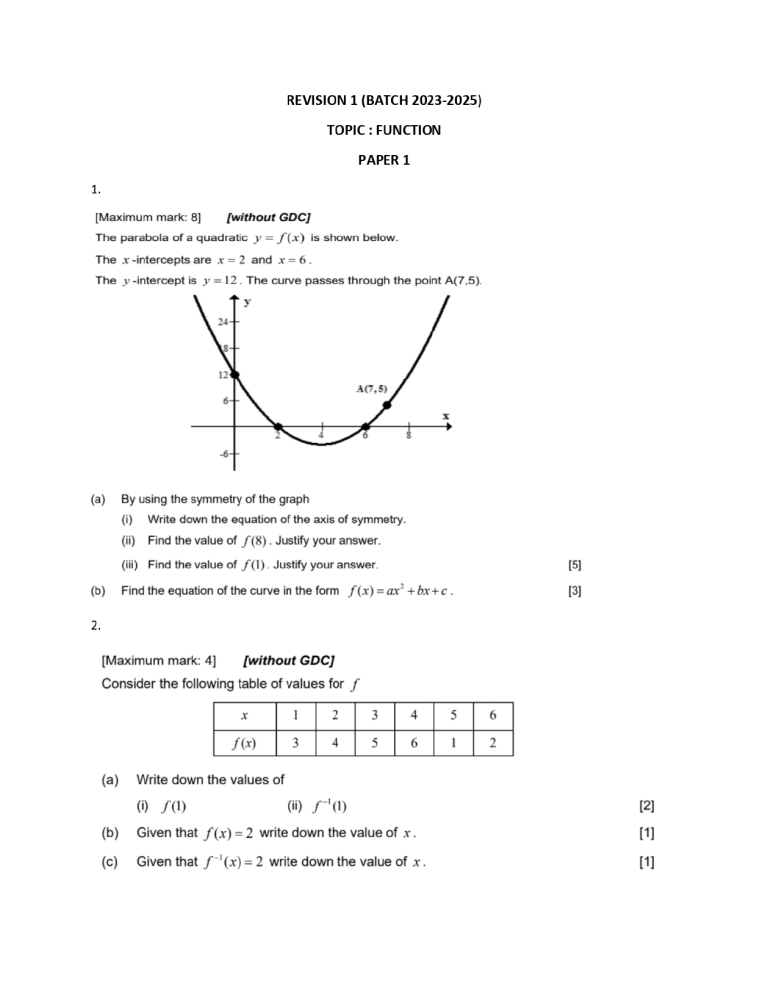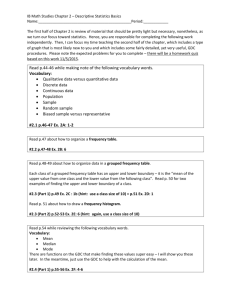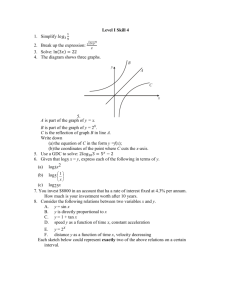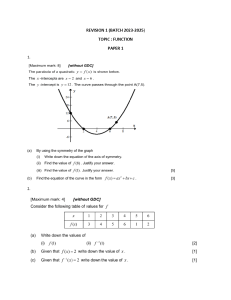
REVISION 1 (BATCH 2023-2025)
TOPIC : FUNCTION
PAPER 1
1
[Maximum mark: 8]
[without GDC]
The parabola of a quadratic y = f(x)
The
x-interceptsare
The
y-interceptis y =12. The curve passes through the point A(7,5).
(a)
x=2
and
is shown below.
x=6.
By using the symmetry of the graph
(b)
(i)
Write down the equation of the axis of symmetry.
(i)
Find the value of f(8). Justify your answer.
(iii)
Find the value of f(1). Justify your answer.
Find the equation of the curve in the form
[5]
f(x) = ax’ +bx+c.
3]
2.
[Maximum mark: 4]
[without GDC]
Consider the following table of values for [
(a)
x
1
2
3
4
5
6
S
3
4
5
6
1
2
Write down the values of
i) sm
(b)
Giventhat f(x)=2
(c)
Giventhat f'(x)=2
@iy /()
write down the value of x.
write down the value of x.
[2
1
1]
3.
[Maximum mark: 8]
[without GDC]
The tables below show some values of two functions /" and g
x
[1[2[3]4
fo
[2]3]1]3
x
e
Write down the values of
[1]2]3]4
|53 |1]3
g(3), f'(3).
[2]
Calculate (f©g)(2)
[2]
Calculate (g
2]
g)(3)
Find a solution of the equation (go f)(x)=3.
[Maximum mark: 6]
2]
[without GDC]
Consider the functions f and
g where f(x) =3x—5and g (x) =x—2.
Solve the equation (f ' = g) (x) = (g ' *f) (x).
5.
[Maximum mark: 9]
[with / without GDC]
The function f* is given by f'(x) = ¥ —6x+ 13, forx>3.
(a)
Show that
/' may
(b)
Hence find the inverse function /.
2
31
State the domain and the range of 1.
2]
State the domain and the range of /.
2]
also be written in the form /'(x) = (x — 3)* + 4.
[Maximum
mark: 7]
[without GDC]
The functions f and
Some
g are both defined in the interval [-4,4] and
g is invertible.
values of the functions are given below.
x
S
|[1[3]4
x
[3|2]1
gx)
(a)
Calculate
(f o f)1).
(b)
Calculate
(g' o f)(4).
(c)
Find a solution of the equation
(d)
Calculate
|1]3]4
|4
1]-3
[2]
2]
[2]
W]
(/o g)(x)=1.
(g7 cg)(2).
[Maximum mark: 4]
[without GDC]
The graph of the function f is shown below. On the same diagram sketch the graph of
the function f '
8.
[Maximum mark: 10]
[without GDC]
The function f(x) is defined by f(x)=
3
(a)
Showthat f is a self-inverse function, thatis /' = f
(b)
Hence find, in terms of k, the valueof (f = f)(k), where
The
figure
below
domain—2 < x<2.
shows
a sketch
of a one-to-one
The graph of y = g(x)
the range of g(x) is ~5< g(x)<6.
function
4
k=3
g(x)
U}
.
defined
over
the
consists of two straight line segments and
(c)
Find the valueof (f o g)X-2).
(d)
On the
same
diagram
above,
2]
sketch the graph of the inverse function y = g '(x)
9.
[Maximum mark: 6]
[without GDC]
The sketch shows part of the graph of y = f(x) which passes through the points
m
A(-1, 3), B(0. 2). C(1. 0). D(2, 1) and E(3, 5).
A second function is defined by g (x}=2{(x
10.
1),
(a)
Caleulate g{0), g (1), g(2) and g (3).
(b}
Onthe same axes. sketch the graph of the function gix).
3]
(3]
[Maximum mark: 6]
(a)
[with / without GDC]
13)
Express y=2x"-12x+23 inthe form y =2(x—c)’ +d.
The graph of y = x is transformed into the graph of y = 2x* ~12x+23 by the
transformations
a vertical stretch with scale factor & followed by
a horizontal translation of p units followed by
a vertical translation of g units.
(b)
Writedownthevalueof ()
k:
(i)
p;
(i)
g.
13)
11.
Let f(x)=3(x+1)" =12.
(@)
Showthat f(x)=3x’+6x-9.
(b)
Forthe graphof f
(i)
12)
write down the coordinates
of the vertex;
(i)
write down the equation of the axis of symmetry;
(ili)
write down the y -intercept;
(iv)
find both x -intercepts.
8]
(2
(c)
Hence sketch the graph of /.
(d)
Let g(x)=x".The
graph of / may be obtained from the graph of g by the two
transformations:
a stretch of scale factor ¢ in the y-direction
N\
followed by a translation of ["}
q
Find (P] and the value of 7.
q
12.
i3]
[Maximum mark: 7]
[without GDC]
The graph of a function / is shown below.
-+
I
1
¢
T
7
&
T
3%
|
o
n
3
.
'
'
‘
'
'
'
'
H
H
(a)
Write down the equation of the horizontal asymptote.
(b)
Write down the equations
of all vertical asymptotes.
(c)
Complete the following table
(1)
lim f(x)=
@)
lim f(x)=
(2)
lim f(x)=
(5)
lim f(x)=
@)
lim f(x)=
(6)
lim f(x)=
'
(d)
13.
m
U}
3]
State the results from question (c) which justify
(i)
the horizontal asymptote
(ii)
the vertical asymptotes.
2]
[Maximum mark: 17]
[without GDC]
Consider
the functions / and g where
f(x)=3x-5
and g(x)=x-2.
(a)
Find the inverse function, f .
3]
(b)
Giventhat g '(x)=x+2,find (g f)(x).
2
(c)
Given also that (f log}(x):%s,sowe S eg)n)=(g"
Let h(x):M,
8(x)
(d)
(i)
« ).
2
x#2.
Sketchthegraphof i for ~-3<x<7
and -2 < y <8, including
any
asymptotes.
(e)
5]
(i)
Write down the equations of the asymptotes.
()
Find h'(x)
(i)
Write down the equations of the asymptotes of 4
The graph of ¥ = f(x)
is shown below.
PROTR—r
[without GDC]
i eecccscccassassasapabas
[Maximum mark: 5]
R
14.
5]
wt
Onamwmnmmunhagmwdy=fi‘lndcmannyasyrrm.
x
15.
The graph of y = f(x)
is shown below.
Onanewdiawamsmmmegramoly:f%,lndic-to-nyaxynwm.
X
16.
[Maximum mark: 6]
[without GDCJ
Each of the diagrams below shows the graph of a function /.
Sketch on the given axes
the graph of
(@
|rex):
L/B
17.
[Maximum mark: 7]
[without GDC]
The diagram shows the graph of f(x).
It has a maximum at A(1.5, 2), a vertical
asymploteat x =4 and the y-intercept is at (0.%). Let g(x)= %
X
(a)
Write down the coordinates of
(i)
(b)
The y-interceptof y = g(x)
(ii) The local minimumof y = g(x)
On the same diagram, sketch the graph of y = g(x).
2]
5]
On the same diagram, sketch the graph of y = g(x).
ot
¥
A(15.2)
151
Ionssssssussasessahdnessssnsssssesassssssassessassssssasss
(b)
19.
[Maximum mark: 4]
[without GDC]
The diagram represents the graph of the function f : x> (x=p)(x—q).
Y,
(a)
Write down the values of p and ¢.
2
(b)
The function has a minimum value at the point C. Find the x -coordinate of C .
2
20.
[Maximum
mark: 4]
[without GDC]
The diagram shows the parabola
y = (7 —x)(1 + x). The point B is the maximum
point
and the points A, C are the x -intercepts. Find the coordinates of A, B and C.
V
U|
\C
x
21
[Maximum mark: 4]
[with / without GDC]
Consider the function f(x)=2x’-8x+5.
(a)
Express f(x) inthe form a(x— p)’ +q, where a,p,q e Z.
[3]
(b)
Find the minimum value of f(x).
]
22.
[Maximum
Let f{x)=
mark:
§]
Iwithout GDCJ
pix—gWx—r).
Partof the graph of
iz shown below.
Tha graph passes thraugh the points (—2, Oy, {0, —4) and (4, 0).
{a)
(b)
(g}
Write down the value of g and of »
4]
Write down the equation of the axis of symmetry.
[11
Find the value of g
[3]
23
The diagram shows part of the graph of the curve y =a(x - k)’ +k .where a, h, k € Z.
¥
\
/
Y
20
\
/
/
/
/
154\
10
P(5,9)
5+
T
T
2
s
T
s
s
T
6w
(@)
The vertex is at the point (3, 1). Write down the value of & and of & .
2
(b)
The point P (5, 9) is on the graph. Show that @ = 2
3]
(c)
Hence
show that the equation of the curve can be written as y =2x*
=12x+19.
[1]
24
[Maximum mark: 5]
[without GDCJ
The function f(x) is defined as f(x) = ~(x - fl)l +k . The diagram below shows part
of the graph of f{x). The maximum point on the curve is P (3, 2).
I
§
(a)
Write down the value of
T
Lk
- /.\\
1|
VAR
(i) &
(i) &
12
(b)
Write down the possible valuesof f{x).
@
()
Show that f{x) can be writtenas f(x)=—x" +6x-T.
m
25
[Maximum mark: 5]
[without GDC]
Part
of the graph
of the function y = d (x ~mr)’ + p is given in the diagram below.
The x-intercepts
are (1, 0) and (5, 0). The vertex is V(m, 2).
(a) Write down the value of (i) m
(b) Findd.
(i) p
3
2
28.
[Maximum mark: 12]
[without
GDC]
Let f(x)=a(x~4)"
+8.
(a)
Write down the coordinates of the vertex of the curve of [
(b)
Giventhat f(7)=-10,
find the value of a.
(c)
Hence find the y -intercept of the curve of | .
(d)
(e)
Find the x -intercepts
of the curveof /.
Sketch the graph of the curve of /.
29.
[Maximum mark: 8]
Let f(x)=x"+x, xs—% and g(x)=x", x<0.
(a)
Describe the sequence of transformations that map g(x) to f(x).
[
(b)
Find f'(x)
[
and state its domain.





